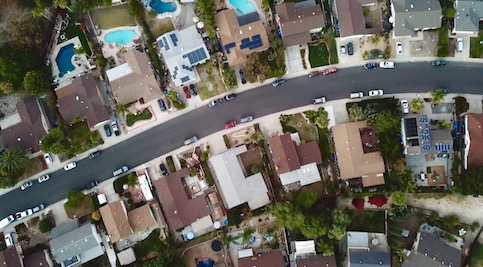When buying a home, there are several costs you need to pay besides principal and interest. Along with property tax, homeowners insurance is a major expense homeowners need to budget for. But how much is homeowners insurance? According to Insurance.com, the average cost of homeowners insurance in 2023 is around $2,777 annually. However, it can fluctuate widely depending on location and value, among other factors.
What Determines The Cost of Homeowners Insurance?
There are a lot of factors that determine the cost of homeowners insurance. Here are some of the most common ones:
- A home’s value: A more expensive property comes with a higher insurance cost.
- Age of your home: An older home will come with a higher insurance premium because it’s more likely to have an issue.
- A home’s location: Some areas are more likely to have claims due to crime, weather and other outside factors, and this can cause your insurance cost to go up.
- Your coverage level: A home with a low deductible and minimal coverage is going to have cheaper insurance premiums than a home with a low deductible and several insurance riders.
- Your claims history: If you have filed a lot of claims in the past, it’s possible you’ll have to pay higher home insurance premiums.
- Your credit: Some states allow insurance companies to factor your credit score into your premium cost. The idea is that, if you have a high credit score, you’re less likely to file a claim or miss a payment.
Will My Homeowners Insurance Ever Go Up?
Yes, your homeowners insurance will go up. If you file claims, these could affect your premium. For example, if a tree branch falls, damages your roof and breaks a window, you may be tempted to file a claim. Let’s say you’re quoted $1,200 for repairs and you have a $1,000 deductible. It may make more sense just to pay the whole thing out of pocket than to risk having your premium go up.
Other ways your insurance costs can go up include if you build an addition to your home or make significant renovations. These will both add value to the home, which means that there’s an increase in replacement cost if the home is damaged. On top of these, if you add a swimming pool, tree fort or swing set, you may see your premium increase. These additions can add liability and medical risk, which can open you up to a lawsuit or medical costs due to injury.
But the truth is, insurance premiums can go up without you doing anything, too. In fact, many homeowners are experiencing insurance rate hikes right now. A major reason for rising rates is inflation. As housing costs and labor and materials costs go up, so do homeowners insurance rates. Houses cost more and it costs more to fix them, so homeowners insurance companies may pass the cost onto you.
See What You Qualify For
Buy A Home
Discover mortgage options that fit your unique financial needs.

Refinance
Refinance your mortgage to have more money for what matters.
Tap Into Equity
Use your home’s equity and unlock cash to achieve your goals.
Do Homeowners Insurance Costs Vary By State?
Yes, homeowners insurance costs vary significantly by state. States with higher weather incidents, for instance, come with higher homeowners insurance costs. Some states also mandate what is and isn’t included in standard homeowners policies. For instance, Hawaii excludes hurricane damage, which causes the state to have lower homeowners insurance costs. The following table on homeowners insurance costs by state is sourced from Insurance.com and recent as of April 1, 2023. Below are the average costs per month. If you have a mortgage, these are the amounts that will be part of your escrow payment, which is part of your monthly mortgage payment.
Alabama | $291 |
|---|---|
Alaska | $178 |
Arizona | $185 |
Arkansas | $350 |
California | $115 |
Colorado | $305 |
Connecticut | $198 |
Delaware | $130 |
Florida | $197 |
Georgia | $252 |
Hawaii | $49 |
Idaho | $204 |
Illinois | $229 |
Indiana | $258 |
Iowa | $215 |
Kansas | $251 |
Kentucky | $308 |
Louisiana | $242 |
Maine | $146 |
Maryland | $141 |
Massachusetts | $134 |
Michigan | $217 |
Minnesota | $244 |
Mississippi | $320 |
Missouri | $292 |
Montana | $226 |
Nebraska | $408 |
Nevada | $150 |
New Hampshire | $129 |
New Jersey | $130 |
New Mexico | $244 |
New York | $172 |
North Carolina | $253 |
North Dakota | $262 |
Ohio | $189 |
Oklahoma | $443 |
Oregon | $183 |
Pennsylvania | $183 |
Rhode Island | $157 |
South Carolina | $254 |
South Dakota | $320 |
Tennessee | $259 |
Texas | $345 |
Utah | $146 |
Vermont | $128 |
Virginia | $187 |
Washington | $138 |
West Virginia | $212 |
Wisconsin | $169 |
Wyoming | $203 |
What States Are The Most Expensive?
Oklahoma, Kansas, Nebraska, Arkansas and Texas all have the highest homeowners insurance rates. The average rate for Oklahoma is $443 per month (about $5,316 annually) on a $300,000 home.
What do these states have in common? They all have a high number of natural disasters. Texas, Kansas, Nebraska and Oklahoma have the most tornadoes on average. Arkansas experiences severe storms, and if you live near the Mississippi River, you may want to consider flood insurance. High winds, hail and lightning can all cause a lot of damage, which is reflected in these high rates.
What States Are The Cheapest?
Hawaii, California, Washington D.C., Vermont and New Hampshire have the cheapest home insurance rates. Hawaii’s average annual rate for a $300,000 home is $49 per month (about $582 annually), but keep in mind that this doesn’t cover hurricane damage. Also note that, in California, it can be hard to get homeowners insurance in areas with wildfire risk.
Places like Vermont and New Hampshire have low rates due to low risk. They’re less populated and less prone to natural disasters.
Does The Cost Of Homeowners Insurance Change Based On The City?
Homeowners insurance changes based on the city you’re in, but it also changes based on the part of the city. Cities with lower housing costs are going to naturally have lower homeowners insurance. Also, cities that aren’t near water and don’t experience frequent natural disasters will have lower rates than cities along major rivers, near the ocean or that see tornadoes or hurricanes.
Your proximity to things like a police station, fire station or hospital can also have an impact. The idea here is that if there’s an incident, such as a fire, homes closer to city services will receive less damage. That translates to a lower rate. Places with a high crime rate will also come with higher insurance rates, as there’s a greater chance of vandalism or burglary, triggering a claim.
What’s Covered Under Homeowners Insurance?
Knowing how much homeowners insurance costs is the half of it. Next, you’ll need to know what that cost covers. In general, homeowners insurance covers:
- Your house
- Other structures like fences and sheds
- Personal property on your property
- Liability for things that happen on your property
- Medical payments if someone is injured on your property
However, note that there are exclusions. One major one is that homeowners insurance doesn’t cover damage by flooding. It also may not cover some damages if your home has been vacant for more than 60 days. So, if you’re taking an extended vacation or snowbirding, you may need to contact your insurance company to make sure you’re covered.
There’s also a distinction between insurance policies that cover cash value or that pay full replacement costs. Cash value pays out what your personal property is worth currently. So if your 3-year-old laptop is stolen in a burglary, they’ll pay you what it’s worth. That means they may only pay you $600, even if it would cost you $2,000 to replace it. Replacement cost coverage means just that – if your laptop is stolen, they’ll pay you the $2,000 it costs to replace it, for example.
Homeowners Insurance Vs. Private Mortgage Insurance
Homeowners insurance and private mortgage insurance (PMI) are two different costs. Homeowners insurance protects the homeowner and their property from damage and other risks. PMI is a charge put on conventional mortgages where the homeowner has less than 20% equity. This is insurance for the lender in case the homeowner doesn’t pay their mortgage.
You can’t get rid of homeowners insurance while you live in your home, but you can remove your mortgage insurance if you have a conventional loan. Once you reach 20% equity, call your mortgage lender and ask about removing your PMI. If you don’t request it be removed, your lender will automatically remove it once you reach 22% equity.
Homeowners Insurance Cost FAQs
You asked and we’re answering. Here are some frequently asked questions about homeowners insurance.
How do you get the best homeowners insurance rate?
To get the best homeowners insurance rate, you need to shop around. Compare multiple insurance companies because they each may have different criteria on how they adjust insurance rates. Don’t be afraid to talk to multiple insurance companies. Let them know you’re shopping around and looking for a good rate.
Also, research the type of insurance coverage you want. Just because one company offers a lower rate doesn’t mean it’s a better idea. Compare the rates, but also compare the coverage. The last thing you want to do is skimp on coverage and then end up regretting it due to a damaging disaster.
Is paying the annual premium cheaper than paying monthly?
In general, homeowners insurance companies charge extra for homeowners to pay insurance monthly. However, most homeowners with mortgages pay their homeowners insurance with an escrow account. With an escrow account, a portion of your monthly mortgage payment is put aside in an account for paying homeowners insurance, as well as property taxes. Your mortgage lender then pays the homeowners insurance premium yearly.
If you don’t have a mortgage, you may be able to elect to pay your homeowners insurance monthly. Just know that this can come with an increase in cost, often in the form of processing fees.
How can I save on my homeowners insurance policy?
You can reduce your coverage, raise your deductible, live in a less risky area, improve your credit score or move to a more affordable house. All of these can help you save on your homeowners insurance policy.
However, the easiest way to reduce your policy may be to shop around. You may be able to get a cheaper rate if you bundle your home and auto insurance policies with the same company. Other discounts you should look into include a paperless billing discount and a discount for adding home security.
The Bottom Line
So, how much is homeowners insurance? The real answer is that it depends. Your location, coverage, home value and even your credit score can all come into play to determine how much you’ll pay. In states like Oklahoma and Kansas, you’ll see high average homeowners insurance costs. Whereas states with less weather and natural disaster risk come with lower premiums.
When you’re buying a home, it’s important to research homeowners insurance costs in the area. These costs can be a major part of your monthly mortgage payment. Once you’ve decided on an area, shop around to see which homeowners insurance company will give you the best rate.
Ready to Find Out What You Qualify For?
See options that work for your unique financial situation.

Victoria Araj
Victoria Araj is a Staff Writer for Rocket Companies who has held roles in mortgage banking, public relations and more in her 15-plus years of experience. She has a bachelor’s degree in journalism with an emphasis in political science from Michigan State University, and a master’s degree in public administration from the University of Michigan.












